Top Tier CPU Air Coolers Q3 2015: 9-Way Roundup Review
by E. Fylladitakis on July 6, 2015 8:00 AM ESTThe Noctua NH-D15
Noctua is one of the world's most renowned cooler manufacturers. The company is especially well known for their high end and specialty products, aimed to those seeking extreme performance and or very low noise solutions. The cooler that the company provided us for this review is no other than the NH-D15, a behemoth based on the highly popular NH-D14.
The NH-D15 is supplied in a large cardboard box with a minimalistic, elegant design. Highlighting the main features of the cooler is the primary focus of the entire artwork. Inside the main box, we found the bundle packed into separate cardboard boxes and the cooler protected within a polyethylene foam construct. The bundle consists of the hardware necessary for the mounting of the cooler, an L type Philips PH2 screwdriver, a fan power cable splitter, two fan speed reducers, a tube of NT-H1 thermal grease, a metallic case badge, four rubber fan mounts and four wire clips for the two cooling fans.
Many people erroneously think that the NH-D15 is just a little larger version of the very popular NH-D14. The NH-D15 is a reverse-symmetric dual tower design based on the NH-D14, but there are numerous improvements. Noctua technically merged the core design of the NH-D14 with the fin design of the NH-U14S, which has the first seven fins of each tower shortened. This way, the NH-D15 can offer much wider compatibility with RAM modules if only the center fan is installed.
The rest of the fins are symmetric, meaning that both their sides are identical, which is mostly straight with a single small triangular notch at the center and a few more similar notches near the sides. In order to install/remove the NH-D15, the center fan needs to be removed. Another interesting point is that the fans can be moved upwards, several centimeters if needed be. Moving the front fan upward can allow the installation of tall RAM modules for a small impact on performance but it also requires a very wide case to do so.
Noctua provides two of their own NF-A15 140 mm fans alongside the NH-D15. Their brown/beige color is Noctua's trademark and unique to Noctua's products (or copies of them). These are very high quality fans, with SSO2 bearings (advanced liquid lubricated metallic bearings with magnetic stabilizers), rubber anti-vibration pads and ridged blades for airflow manipulation. For those that do not want to install the second fan on the cooler, because either they need to retain compatibility with certain RAM modules or they are simply satisfied with the performance of a single fan, Noctua provides rubber mounts for the installation of one NF-A15 as a case fan.
The base of the NH-D15 is relatively small in comparison to that of other coolers, yet obviously large enough to cover the entire surface of current CPUs. Most of the base is made out of copper, with steel parts used for retention, all nickel plated, along with the copper heatpipes as well. There are "only" six 6 mm heatpipes, the same number and size as with the older NH-D14, as Noctua clearly does not believe that enlarging the base and adding more heatpipes would make a notable performance difference. The contact surface is smooth and fairly well polished but not machined down to a perfect mirror finish.


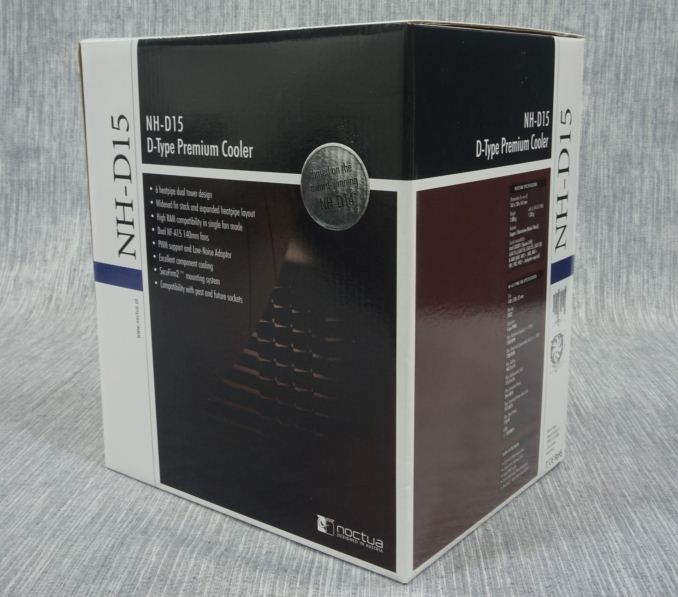
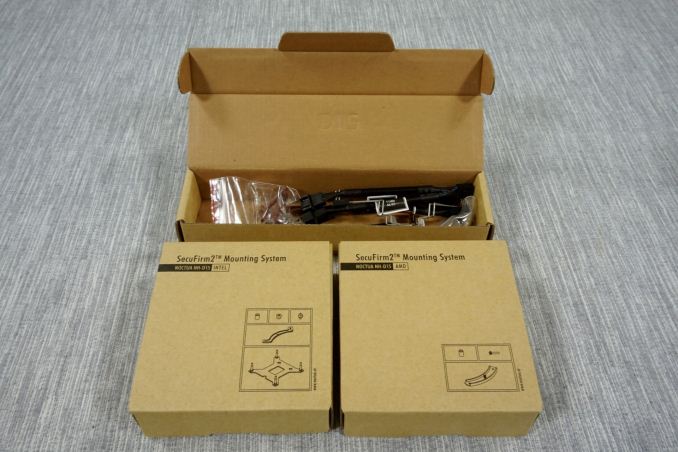
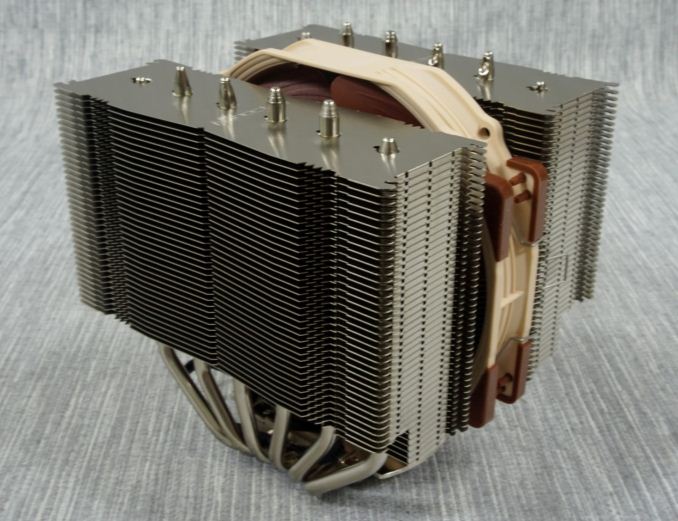
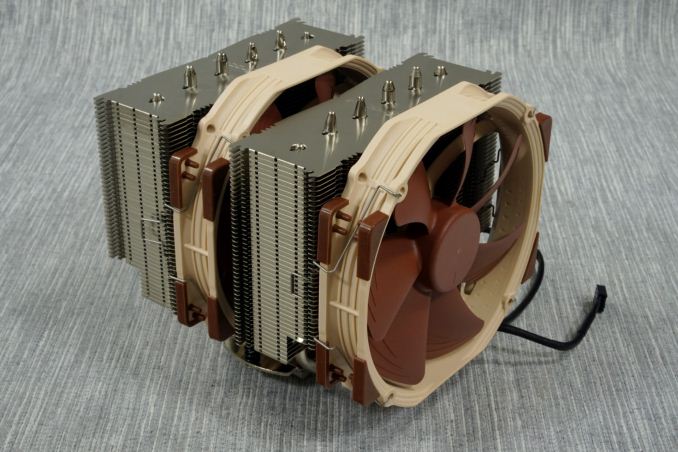
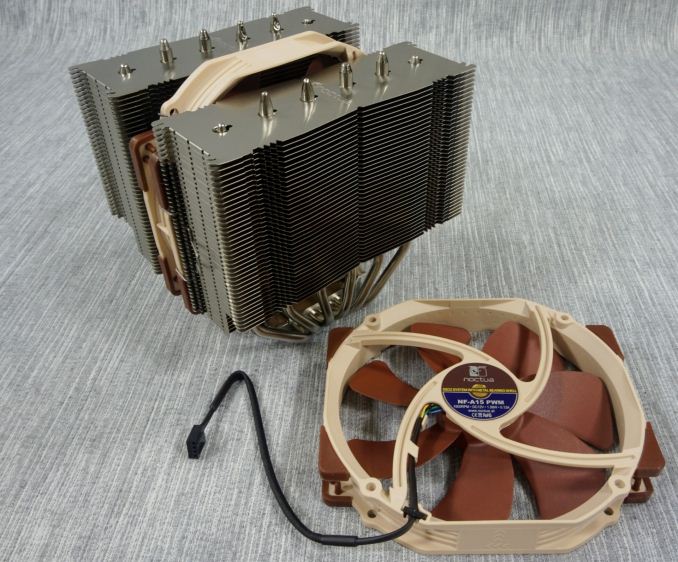
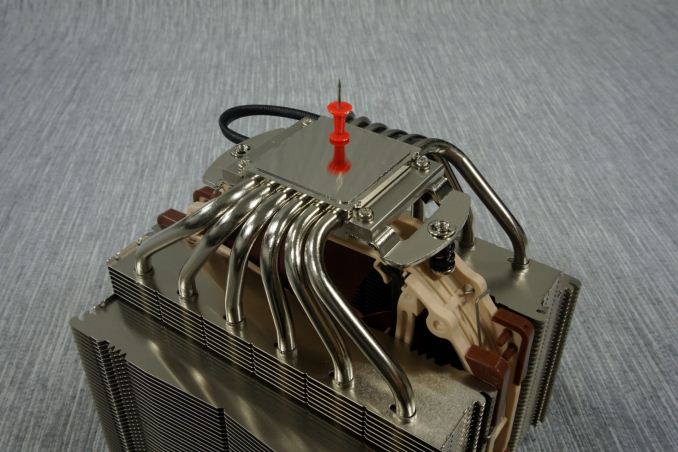








135 Comments
View All Comments
Pissedoffyouth - Monday, July 6, 2015 - link
I wonder how a D15 or similar, with the fans removed, would work with a 45w or 65w APU to make a passively cooled PC.ImSpartacus - Monday, July 6, 2015 - link
That's a really interesting consideration.MrSpadge - Monday, July 6, 2015 - link
This will depend greatly on your case airflow. And if you only run short load bursts (browsing etc.) which can easily be absorbed by the heatsink heat capacity or continous loads (games, work), where the exchange of heat from the heatsink to the outside world limits cooling.iamezza - Tuesday, July 7, 2015 - link
With good fan control you could set the fan to switch off below a certain temp. So it could be silent 99% of the time but with a low rpm fan there if needed.Mumrik - Tuesday, July 7, 2015 - link
You'd probably still need some level of airflow.I've never had a fan on my Scythe Ninja that cools an i5-2500k. I think that's a 95W TDP.
It's close to the single 12cm rear exhaust though.
Beany2013 - Wednesday, July 8, 2015 - link
I did similar with my old SLACR Q6600 95w CPU - Noctua D14 (I think) with a fan on a controller. At stock speeds (with a pair of Noctua case fans on it) it had just enough airflow to run without the CPU fan running at all. When I wanted performance, I could overclock from 2.4ghz to 3.something ghz (I can't remember but I think they went to 3.6ghz?) and just turn the CPU fan up to 'normal' speeds and it'd never get above 70deg and it was still a very quiet machine - HDD noise was far more noticeable than fan noise.I really must get some decent fans for my current rig - a slightly long-in-the-tooth A8-3870 mit 16gb RAM that is still running the OEM cooler. Yes, I've got bored of overclocking. I still have that noctua kit kicking around somewhere, really must dig it out and see if I can get an adapter for it. I'm sure that'll tide me over till we see if Zen is worth a light...?
Essayjedii - Friday, July 10, 2015 - link
I have made a post about D15 in here <a href="http://www.dumblittleman.com/2015/04/14-problems-f... Hope ou find it interesting and useful.Essayjedii - Friday, July 10, 2015 - link
I have made a post about D15 in here http://www.dumblittleman.com/2015/04/14-problems-f...Hope ou find it interesting and useful.
Haravikk - Sunday, July 12, 2015 - link
My current machine is an i7-4790T (45W, 2.7ghz, quad-core, hyper-threaded, 3.9ghz turbo with HD4600 graphics) in an Akasa Euler case, which means the case acts as a heat-sink. As I type this I'm transcoding video on all eight hardware threads with a total load of about 760% (where 800% is max), at a CPU temperature of 85ºC and a clock speed of 2.97ghz.Of course that's for a passive case rather than a heat-sink on its own, but as long as you have somewhere for that heat to go it definitely seems doable. For example if you used an open-air case then ought to just rise out between the heatsink fins so airflow may not be required at all.
Basically keeping the case from becoming a big box of hot air is crucial; the Euler case with my processor (which is a slightly higher TDP than the 35W that the case recommends) gets pretty hot internally, which isn't great for internal drives. I ended up having to swap an mSATA SSD for a 2.5" one, as the mSATA drive just got too hot, while the 2.5" one has a bigger surface area and a metal body. Even so, I squeezed a tiny 40mm fan inside just to help pull hot air out on warmer days.
So ehm… yeah, possible, but you have to be sure you've considered where that heat is going to go before you attempt it. But as others have said; if your case has room then you should just put fans in there anyway and set them to switch off at lower temperatures; you can also use very slow, quiet fans so even if they do run they're silent.
Oxford Guy - Tuesday, July 14, 2015 - link
Stick with a cooler like the NoFan models which are made specifically passive cooling. They will be much more effective.